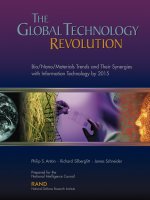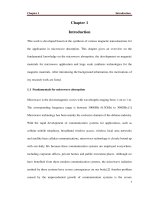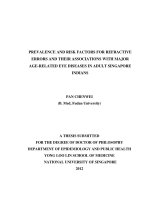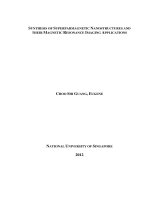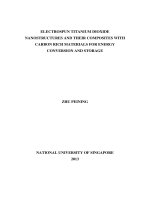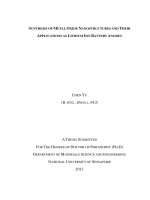Electrospun titanium dioxide nanostructures and their composites with carbon rich materials for energy conversion and storage
Bạn đang xem bản rút gọn của tài liệu. Xem và tải ngay bản đầy đủ của tài liệu tại đây (14.15 MB, 229 trang )
ELECTROSPUN TITANIUM DIOXIDE
NANOSTRUCTURES AND THEIR COMPOSITES WITH
CARBON RICH MATERIALS FOR ENERGY
CONVERSION AND STORAGE
ZHU PEINING
NATIONAL UNIVERSITY OF SINGAPORE
2013
ELECTROSPUN TITANIUM DIOXIDE
NANOSTRUCTURES AND THEIR COMPOSITES WITH
CARBON RICH MATERIALS FOR ENERGY
CONVERSION AND STORAGE
ZHU PEINING
(B. Eng., Huazhong University of Science and Technology)
A THESIS SUBMITTED
FOR THE DEGREE OF DOCTOR OF PHILOSOPHY
DEPARTMENT OF MECHANICAL ENGINEERING
NATIONAL UNIVERSITY OF SINGAPORE
2013
Acknowledgement
First and foremost, I would like to express my greatest gratitude to my supervisor,
Professor Seeram Ramakrishna, for his excellent guidance, support, and encouragement
throughout my entire graduate study. His enthusiasm for science, insightful scientific
ideas, and valuable comments helped me a lot and made it possible for me to conduct
meaningful research and finish this PhD Thesis. Also, I would like to express my sincere
gratitude to my co-supervisor Professor Andrew WEE for his constructive suggestions
and strong support in facilities.
I would like to thank Dr. Sreekumaran Nair from whom I have gained the fundamental
and important knowledge in materials science and engineering and the skills to carry out
the specific researches. Also, he spent so much time to advise me and help me with my
experiments. And I would like to thank Dr. Peng Shengjie for his fruitful discussions and
suggestions for my research project. Also, I am grateful to Dr. M.V. Reddy for the
comprehensive collaboration and discussion on the lithium ion batteries related work.
Also, I would like to thank all the members in our lab for their continue support and
contribution to the friendly atmosphere of the lab.
Special acknowledgement is given to the National University of Singapore for financial
support. Special thanks to Ms. Teo Sharen and other department staffs for their patient
help with all the administrative work. They have always been helpful, providing trainings
and guidance for utilizing the technical facilities.
iii
I deeply appreciate my parents and my dearest friends for their encouraging support
during my PhD study which helped me to overcome the difficult moments of my PhD
work.
Last but not least, I would like to thank every individual who helped me during my PhD
study.
November 2013 in Singapore Peining ZHU
iv
Table of Contents
Declaration i
Acknowledgement ii
Table of Contents iv
Summary xii
List of Figures xv
List of Tables xxiii
List of Publications xxiv
Chapter 1 Introduction 1
1.1 Background 1
1.2 Objectives and Scopes 4
1.3 Structure of the thesis 8
References 9
Chapter 2 Literature Review 14
v
2.1 Dye-Sensitized Solar Cells 14
2.1.1 Structure and Working Principles 14
2.1.2 Recent Study on DSCs 20
2.2 Lithium Ion Battery 23
2.2.1 Structure and Working Principles 25
2.2.2 Recent Study on Lithium Ion Batteries 26
2.3 Titanium Dioxide 28
2.3.1 Structures of TiO
2
28
2.3.2 Recent Study of TiO
2
in the application of DSCs and LIB 31
2.4 Electrospinning 35
2.4.1 Working mechanism of Electrospinning 35
2.4.2 Energy related application of electrospun nanostructures 39
References 40
Chapter 3 Electrospun TiO
2
nanostructures and their 48
applications in Dye-Sensitized Solar Cells
3.1 Introduction 49
3.2 Experiment 51
3.2.1 Fabrication of TiO
2
nanofibers by electrospinning 51
vi
3.2.2 Fabrication of TiO
2
rice grain nanostructure by 52
electrospinning
3.2.3 Preparation of the electrodes with electrospun 52
TiO
2
nanostructures
3.2.4 Fabrication of scattering layers with electrospun 53
TiO
2
nanostructures
3.2.5 Cell assembly 54
3.2.6 Characterizations 54
3.3 Results and Discussion 55
3.3.1 Morphologies and Structures 55
3.3.2 Evolution of the rice grain morphology 63
3.3.3 Application of the electrospun nanostructures as 67
the photoanode materials in DSCs
3.3.4 Application of the electrospun nanostructures 69
as the scattering layer materials in DSCs
3.4 Conclusion 76
References 77
Chapter 4 Electrospun TiO
2
-CNT nanocomposite and its 81
application in Dye-Sensitized Solar Cells
vii
4.1 Introduction 83
4.2 Experiment 85
4.2.1 Preparation of carboxyl functionalized multi-walled 85
carbon nanotubes (MWCNTs-COOH)
4.2.2 Fabrication of TiO
2
–CNT rice grain nanostructure 85
by electrospinning
4.2.3 Fabrication of Dye-sensitized Solar Cells (DSCs) 86
4.2.4 Characterizations 87
4.3ResultsandDiscussion 89
4.3.1MorphologiesandStructures 89
4.3.2 UV-Vis, Raman, FT- IR, and XPS Spectra 93
4.3.3 Application in Dye-Sensitized Solar Cells 99
4.4 Conclusion 106
References 107
Chapter 5 Electrospun TiO
2
-graphene nanocomposite and 111
its application in Dye-Sensitized Solar Cells
5.1 Introduction 112
viii
5.2Experiment 114
5.2.1 Synthesis of CTAB stabilized graphene 114
5.2.2 Fabrication of TiO
2
–graphenne rice grain nanostructure 114
by electrospinning
5.2.3 Fabrication of Dye-sensitized Solar Cells (DSCs) 115
5.2.4 Characterizations 116
5.3 Results and Discussion 118
5.3.1 Morphologies and Structures 118
5.3.2 UV-Vis, PL, and Raman Spectra 121
5.3.3 Application in Dye-Sensitized Solar Cells 123
5.4 Conclusion 129
References 130
Chapter 6 Electrospun nanostructures-derived titanates/TiO
2
134
nanostructures and their high performances in
Dye- Sensitized Solar Cells
6.1 Introduction 135
6.2 Experiment 137
6.2.1 Fabrication of rice grain-shaped TiO
2
-SiO
2
composites 137
ix
6.2.2 Fabrication of TiO
2
-SiO
2
composite nanofibers 138
6.2.3 Fabrication of anisotropic titanate nanostructures 139
from TiO
2
-SiO
2
composites
6.2.4 Fabrication of porous TiO
2
from electrospun structures 139
via titanates route
6.2.5 Fabrication of dye-sensitized solar cells 140
6.2.6 Characterizations 140
6.3 Results and Discussion 142
6.3.1 Morphology of the as-spun nanofibers and sintered 142
TiO
2
-SiO
2
nanostructures
6.3.2 Morphology of the titanates 143
6.3.3 Morphology of the nanostructures from 147
control experiments
6.3.4 Structure of the titanates 148
6.3.5 BET surface area of the titanates 153
6.3.6 Effect of temperature 153
6.3.7 Morphology evolution 154
6.3.8 Applications of the titanates in dye-sensitized solar cells 156
6.3.9 Morphology and the structures of the 158
titanates-derived TiO
2
x
6.3.10Applicationoftitanates‐derivedTiO
2
in162
dye‐sensitizedsolarcells
6.4 Conclusion 164
References 165
Chapter 7 Electrospun TiO
2
nanostructures and their 168
applications in lithium ion batteries
7.1 Introduction 169
7.2 Experiment 170
7.2.1 Fabrication of Rice grain-shaped TiO
2
& 170
TiO
2
-MWCNT Composites
7.2.2 Fabrication of TiO
2
nanofibers 171
7.2.3 Fabrication of Lithium Ion Batteries 171
7.2.4 Characterizations 172
7.3 Results and Discussion 173
7.3.1 Structure and morphology 173
7.3.2 Galvanostatic cycling 178
7.4 Conclusion 189
References 190
xi
Chapter 8 Conclusion and Outlook 193
8.1 Conclusions 193
8.2 Outlook 199
xii
Summary
Titanium dioxide (TiO
2
) has been extensively investigated for its excellent photocatalytic
properties, addressing environmental problems such as removal of organic contaminants
in water and air, photonic crystals, UV blockers, self-cleaning materials, dye-sensitized
solar cells (DSCs), and lithium ion batteries. Recently, one-dimensional TiO
2
nanomaterials has gained lots of attentions in the applications of solar cells and lithium
ion batteries for the advantages of high surface area, enhanced light harvesting efficiency,
high intrinsic electron mobility, and semi-directed charge transport. At the same time, the
incorporation of carbon materials (CNT and graphene) into TiO
2
was demonstrated to be
effective in enhancing the properties of latter by facilitating its charge separation and
transport processes, and hence improving the performance of its applications in solar
cells and batteries.
In this work, anisotropic TiO
2
nanomaterials have been fabricated by the easy method of
electrospinning. The as-prepared electrospun TiO
2
presented anisotropic nanostructures
of fibers and rice grains. The electrospun nanofibers are with uniform diameters and
porous structures. The rice grain shaped TiO
2
nanostructure is uniformly distributed,
single crystalline, and with high surface area of 60 m
2
/g. In the application of dye-
sensitized solar cells, the rice grain-shaped TiO
2
showed superior performance than the
electrospun nanofibers and the commercially available P-25 TiO
2
. At the same time,
both electrospun nanofibers and rice grain nanostructures demonstrated good
performance as the scattering layer materials in dye-sensitized solar cells.
xiii
Based on the fabrication of rice grain shaped electrospun TiO
2
with novel interesting
morphology and high performance, TiO
2
-CNT nanocomposite with the same morphology
was successfully fabricated. The results showed that the composite synthesized by the
present process is with CNT integration across the interface and with chemical bonding
between TiO
2
and CNTs. The electrospun TiO
2
-CNT nanocomposites with various
concentration of CNTs were employed in the application of DSCs as photoanodes. It was
found that the optimum concentration of CNTs in TiO
2
matrix for best DSC performance
was 0.2 wt%, which produced an efficiency enhancement of 25% when compared to bare
TiO
2
.
The methodology was extended further in fabricating TiO
2
-graphene nanocomposites. By
the simple method of adding functionalized graphene into the electrospinning solution,
electrospun TiO
2
-Graphene composite was successfully fabricated. The TiO
2
-Graphene
nanocomposite was characterized by the SEM, TEM, XRD, UV-visible, Raman, FT-IR,
BET measurements and photoluminescence (PL) spectroscopy. It was shown that the
incorporation of the graphene into the TiO
2
matrix incresead the charge transport and
collection of the composite, which gave us a 33% enhancement in the efficiency of dye
sensitized solar cells.
Also, based on the fabrication processes developed during this thesis work, , TiO
2
nanostructures with much enhanced porous structure and highly surface area were
fabricated through the route of converting electrospun TiO
2
-SiO
2
nanocomposites to
titanates and then to anatase TiO
2
. During this process, highly anisotropic titanates with
interesting morphology of thorn-like nanofibers and sponge-shaped structures were
xiv
obtained. Furthermore, the titanates were converted back to porous anatase by the acid
treatment, with the high surface areas retained. The as-obtained titanate-derived TiO
2
showed great performance up to 7% efficiency in the application of DSCs.
At the same time, the electrospun TiO
2
nanostructures and TiO
2
-CNT nanocomposites
were applied in the field of lithium ion batteries for the purpose of energy storage. These
materials showed the promising performance as the long term cycling anode materials in
lithium ion batteries. The electrospun TiO
2
showed a long term cycling stability and a
stable performance up to 800 cycles, with capacity retention of 92% ( 10 to 800 cyc.) and
81% ( 10 to 800 cyc.) for nanofibers and rice grain nanostructures, respectively. At the
same time, the TiO
2
-CNT rice grain-like composite nanostructures showed enhancement
in the capacity retention (10 to 800 cyc.) by increasing the retention from 81% to 92%.
On conclusion, this work presented in this thesis demonstrated the fabrication of an
interesting, novel, and high performance electrospun nanostructures of rice grains. At the
same time, the electrospinning was demonstrated to be a simple and effective method to
incorporate CNT and graphene into the TiO
2
matrix. The as-prepared TiO
2
-
CNT/graphene composites were systematically investigated and demonstrated good
enhancements in the application of solar cells compared to the bare TiO
2
nanostructure.
Moreover, a new method of titanates-route was developed and successfully improved the
properties of electrospun TiO2 nanostructures as well as their applications of solar cells.
At the same time, the as-prepared electrospun TiO
2
and TiO
2
/carbon composite were
demonstrated to be good candidate for the long-term stable lithium ion batteries.
xv
List of Figures
Fig. 1.1 Flow chart for the structure of the thesis.
Fig. 2.1 Schematic of dye sensitized solar cells with the TiO
2
nanoparticles
as the photo electrode. Dye molecules are anchored on the surface
of the TiO
2
. Electrons are generated by photo excitation of the dye
and then injected into conduction band of the TiO
2
. The TiO
2
network is percolated with the electrolyte whose redox potential
supports the regeneration of the dye after it gets reduced.
Fig. 2.2 Kinetic processes of Dye- Sensitized Solar Cells.
Fig. 2.3 Current–voltage graph of a typical solar cell.
Fig. 2.4 Schematic of the electrode with scattering layer.
Fig. 2.5 Schematic of the electron transport in the nanoparticle and one-
dimensional structure electrodes.
Fig. 2.6 Comparison of the different battery technologies in terms of
volumetric and gravimetric energy density.
Fig. 2.7 Structure diagram of lithium ion battery. During discharge, lithium
ions transfer through the electrolyte and the separator from the
anode and intercalate into the cathode material, providing energy
to the load connected to the battery.
Fig. 2.8 Modes of link among [TiO6] octahedron in (a) rutile (b) anatase,
the projection along the b axis (the thick line shows the edge-
shared link), (c) brookite.
Fig. 2.9 Valence band and conduction band position of various
semiconductors in contact with aqueous electrolyte at pH 1.
Fig. 2.10 Electrospinning setup: a syringe containing a polymeric solution
delivers its load through a needle. The needle is connected to a
high continuous voltage supply, an electric field between the tip
and the grounded collector is thus created and allows fibers
formation.
9
15
16
17
20
21
24
24
29
30
35
xvi
Fig. 3.1 SEM images of the as-spun PVP-TiO
2
composite nanofibers (A
and B) and the TiO
2
nanofibers (C and D) after high temperature
sintering.
Fig. 3.2 TEM images of the TiO
2
nanofibers in low (A) and high
magnifications (B). The high resolution lattice resolved image (C)
and SAED pattern (D) of TiO
2
nanofibers.
Fig.3.3 SEM images of the as-spun PVAc-TiO
2
composite nanofibers (A
and B) and the TiO
2
rice grain nanostructures (C and D) after high
temperature sintering.
Fig. 3.4 TEM images of the TiO
2
rice grain nanostructures (A and B). The
high resolution lattice resolved image (C) and SAED pattern (D) of
TiO
2
rice grain nanostructures.
Fig. 3.5 X-ray diffraction patterns of TiO
2
nanofibers (A) and rice grain
nanostructures (B).
Fig. 3.6 SEM images of the as-spun PVAc-TiO
2
fibers (A and B) heated to
(C) 100
o
C, (D) 200
o
C, (E) 300
o
C and (F) 400
o
C, respectively.
Fig. 3.8 I-V characteristics of different cells with electrospun TiO
2
nanofibers, rice grain nanostructures, and P25 as the photoanode
materials.
Fig. 3.10 Cross-sectional SEM images of (A) TiO
2
nanoparticles/nanofiber
electrode and (B) TiO
2
nanoparticles/rice grain nanostructure
electrode. Expanded images of the scattering layers are shown in
top panels.
Fig. 3.11 UV-visible spectra of different electrodes. (b) Photocurrent
density-voltage characteristics of different electrodes. The inset is
the IPCE spectra of the electrodes.
55
56
57
59
60
63
66
69
71
xvii
Fig. 4.1 SEM images of the as-spun TiO
2
-CNT-PVAc (A) and TiO
2
-PVAc
nanofibers (C). The sintered TiO
2
-CNT nanocomposite and TiO
2
are shown (B) and (D), respectively, revealing the rice grain-
shaped morphology.
Fig. 4.2 SEM image (A), TEM image (B), SAED pattern (C); and lattice-
resolved image (D) of TiO
2
-CNT nanocomposite.
Fig. 4.3 SEM (A) and TEM (B) image, respectively, of TiO
2
-CNT
nanocomposite with high CNT content (8 wt%).
Fig. 4.4 XRD patterns of TiO
2
and TiO
2
-CNT nanocomposite.
Fig. 4.5 UV-visible absorption spectrum of rice grain-shaped TiO
2
and
TiO
2
-CNT composite. The traces have been offset for clarity.
Fig. 4.6 Raman spectra of TiO
2
(black trace), functionalized MWCNTs
(blue trace), and TiO
2
-CNT nanocomposite (red trace).
Fig. 4.7 The FT-IR spectra of TiO
2
(black trace) and TiO
2
-CNT
nanocomposite (red trace).
Fig. 4.8 XPS spectra of TiO
2
(A) and TiO
2
-CNT (B); and high-resolution
XPS spectra of Ti 2p peak of TiO
2
(C) and TiO
2
-CNT (D), and O
1s (E) of TiO
2
-CNT.
Fig. 4.9 I-V characteristics for CNTs-incorporated TiO
2
electrode in DSCs
and cross-sectional SEM image showing the thickness of the
electrodes (inset image).
Fig. 4.10 UV-VIS spectra of dye detached from TiO
2
and TiO
2
-CNT (0.2
wt %) electrodes.
Fig. 4.11 Energy band diagram illustrating the charge injection and charge
transport from excited sensitizer into TiO
2
and to the conductive
glass without (a) and with (b) CNT networks, and the equilibration
of the Fermi levels (from E
f
to E
f
*).
88
90
91
92
93
94
95
97
98
100
100
xviii
Fig. 4.12 IPCE of the solar cells with TiO
2
and TiO
2
-CNT (0.2 wt %)
electrodes.
Fig. 4.13 Impedance spectra of solar cells with TiO
2
and TiO
2
-CNT (0.2
wt %) nanocomposite electrodes, measured at −0.70 V bias in the
dark. A) Nyquist plots, B) Bode phase plots.
Fig. 5.1 A Schematic of the fabrication of TGCs by electrospinning. A
polymeric solution consisting of PVAc, dispersed graphene, acetic
acid and TIP was electrospun to get a nanofiber mat which was
subsequently sintered at 450
0
C for 1 h to obtain the rice grain-
shaped TGC.
Fig. 5.2 AFM image (A), Raman spectrum (B), and TEM images (C and D)
of functionalized graphene.
Fig. 5.3 SEM (A) and TEM (B) image of TiO
2
-graphene composites (TGC).
TEM (C) and lattice-resolved image (D) of a single TiO
2
rice grain
nanostructure in TGC. Inset of D shows an SAED pattern showing
the single crystallinity of the TiO
2
.
Fig. 5.4 XRD pattern of TiO
2
-graphenne composite.
Fig. 5.5 UV-Visible spectra of TiO
2
and TiO
2
-graphene nanocomposite.
Fig. 5.6 Photoluminescence (PL) spectra of TiO
2
and TiO
2
-graphene
composite.
Fig. 5.7 Raman spectra of TiO
2
and TiO
2
-graphene composite.
Fig. 5.8 I-V characteristics for TiO
2
-graphene electrodes in DSCs and
cross-sectional SEM image showing the thickness of the electrodes
(inset image).
Fig. 5.9 UV-VIS spectra of dye detached from and TiO
2
and TiO
2
-
graphene (0.5 wt %) electrodes.
Fig. 5.10 IPCE of the cells with TiO
2
and TiO
2
-graphene (0.5 wt %)
electrodes.
102
104
114
117
118
119
120
121
121
123
125
126
xix
Fig. 5.11 Impedance spectra of cells with TiO
2
and TiO
2
-graphene (0.5
wt %) nanocomposite electrodes, measured at −0.70 V bias in the
dark. A) Nyquist plots, B) Bode phase plots.
Fig. 6.1 SEM images of the as-spun TiO
2
-SiO
2
-PVP fibers (A), TiO
2
-SiO
2
-
PVAc fibers (D) and their respective sintered TiO
2
-SiO
2
nanostructures (B&E, respectively). Figure C is the EDS spectrum
of the sintered material showing the elemental composition. Inset
of E shows the TEM image of a single rice grain-shaped TiO
2
-SiO
2
composite and F shows a lattice-resolved image of the same.
Fig. 6.2 SEM image of the TiO
2
-SiO
2
nanofibers (A) obtained from the
TiO
2
-SiO
2
-PVP system. B, C and D show the SEM images of the
titanates in varying resolutions.
Fig. 6.3 SEM images of the sponge-shaped titanates in various resolutions
(A-C). An expanded view of C is given in the inset of D. D shows
the SAED pattern of the NaOH treated sample showing the
absence of Si and the presence of Na.
Fig. 6.4 SEM images of the titanates obtained by treatment with 10 M
NaOH solution (A for the fiber- and B for the sponge-shaped
titanate, respectively). C shows flower shaped structure with an
intrinsic sponge morphology.
Fig. 6.5 SEM images of the nanostructures obtained from control
experiments. A represents the TiO
2
nanofiber and B & C the
titanates obtained from A in low and high resolutions. D, E and F,
respectively, represent the rice grain-shaped TiO
2
and the titanates
in different resolutions.
Fig. 6.6 A& B show low- and high-magnification TEM images of the fiber
titanate. C shows the lattice resolved image depicting the layered
structure of the titanate and its inset gives an SAED pattern. D, E
and F represent the respective images from sponge-shaped titanate
showing its layered nature and polycrystallinity.
127
141
143
144
145
147
148
xx
Fig. 6.7 Representative XPS spectra of the TiO
2
-SiO
2
composites. A shows
the survey spectrum and B, C and D, respectively, show the high-
resolution spectra of the Ti, O and Si.
Fig. 6.8 Representative XPS survey spectrum of the titanate (A) and the
high-resolution peaks of Ti, O and Na (B, C & D respectively).
Fig. 6.9 A comparison of the XRD spectra of nanofiber- and sponge-
shaped titanates (A). B shows the XRD spectrum of the sample
sintered at 450
0
C.
Fig. 6.10 A and B, respectively, denote the SEM images of the titanates
obtained by NaOH treatment at 110
0
C.
Fig. 6.11 Top panel: SEM images showing the evolution of the titanate
morphology (B-D) from TiO
2
-SiO
2
fibers (A). Bottom panel: SEM
images showing the evolution of the sponge-shaped morphology
(F-H) from rice grain-shaped TiO
2
-SiO
2
composites (E).
Fig. 6.12 A comparison of the photovoltaic performance of fiber- and
sponge-shaped titanates (traces a & b, respectively).
Fig. 6.13 XRD spectra of the titanate-derived TiO
2
obtained from TiO
2
-SiO
2
fibers (A) and rice-shaped TiO
2
-SiO
2
composite (B).
Fig. 6.14 SEM images (low- and high-magnification, respectively) of the
titanate-derived TiO
2
. A-fiber shaped, D-rice-shaped. Inset of A
shows a magnified image of the fibers. B & E- high-resolution
TEM images of the fibers and the rice-shaped TiO
2
. Inset of B
shows a magnified image of a fiber. C & F-lattice resolved images,
insets of C & F-SAED patterns revealing the crystallinity of the
TiO
2
.
Fig. 6.15 SEM images of the titanates-derived TiO
2
nanostructure obtained
from the rice grain shaped TiO
2
-SiO
2
composite after 12h NaOH
treatment.
149
150
151
153
154
156
157
158
160
xxi
Fig. 6.16 Current density vs. voltage plots of titanate-derived fiber- (trace a)
and rice-shaped TiO
2
(traces b).
Fig. 7.1 SEM images of electrospun rice grain shaped- TiO
2
nanostructures
in low (a) and high (b) magnifications, rice grain shaped TiO
2
-
CNT (4 wt. %) nanostructures in low (d) and high (e)
magnifications, and TiO
2
nanofibers in low (g) and high (h)
magnifications. SEM images of the composite electrodes made of
carbon black, PVDF, and the rice grain-shaped TiO
2
nanostructures(c), rice grain-shaped TiO
2
-CNT (4 wt. %)
nanostructures (f), and TiO
2
nanofibers (i).
Fig. 7.2 TEM images: (a) High resolution TEM image; (b) High resolution
lattice resolved image; and (c) SAED pattern of electrospun rice
grain shaped- TiO
2
nanostructures. (d) High resolution TEM image;
(e) High resolution lattice resolved image; (f) SAED pattern of
electrospun rice grain shaped- TiO
2
-CNT (4 wt. %) nanocomposite.
(g) High resolution TEM image;, (h) High resolution lattice
resolved image and (i) SAED pattern of a single electrospun TiO
2
nanofiber.
Fig. 7.3 X-ray diffraction patterns of rice grain-shaped TiO
2
nanostructures
(a), TiO
2
-CNT (4 wt. %) nanocomposite (b), TiO
2
-CNT (8 wt. %)
nanocomposite (c), and TiO
2
nanofibers (d).
Fig. 7.4 Galvanostatic discharge-charge cycling curves (voltage vs.
capacity profiles) of rice grain shaped TiO
2
, TiO
2
-CNT
nanostructures, and TiO
2
nanofibers. Current rate: 150 mA g
-1
(0.45 C rates). Li metal was the counter and reference electrodes.
Potential window: 1.0-2.8 V. Number implies the cycle number.
Fig. 7.5 Capacity vs. cycle number of (a) rice grain shaped TiO
2
, (b,c) 4
and 8wt.% TiO
2
-CNT nanostructures, and (d) TiO
2
nanofibers.
Current rate: 150 mAg
-1
(0.45 C rate, assume 1C= 333 mAh g
-1
).
Li metal was the counter and reference electrode. Potential window:
1.0-2.8 V.
161
172
174
176
178
179
xxii
Fig.7.6 TEM images of the TiO
2
rice grain nanostructure (A) and
nanofiber (B) after their utilization as electrode materials for 800
cycles (The nanoparticles surrounding the rice grain nanostructure
are the carbon black nanoparticles from the electrode paste).
Fig.7.7 Galvanostatic discharge-charge cycling curves (voltage vs.
capacity profiles) of CNTs (electrode composition 80:20 PVDF).
Current rate: (a) 40 mA g
-1
(0.12 C rate) and (b)150 mA g
-1
(0.45 C
rate). Li metal was the counter and reference electrodes. Potential
window: 1.0-2.8 V.
Fig. 7.8 Capacity vs. cycle number of all the materials at different rates of
150 mAg
-1
(0.45 C), 300 mAg
-1
(0.9 C) , 500 mAg
-1
(1.5 C) , 750
mAg
-1
(2.24 C) , 1000 mAg
-1
(3 C) , and 1500 mAg
-1
(4.5 C)
). Li
metal was the counter and reference electrode. Potential window:
1.0-2.8 V.
Fig. 7.9 Galvanostatic discharge-charge cycling curves (voltage vs.
capacity profiles) of all the materials at different rates of 150
mAg
-1
(0.45 C), 300 mAg
-1
(0.9 C) , 500 mAg
-1
(1.5 C) , 750 mAg
-
1
(2.24 C) , 1000 mAg
-1
(3 C) , and 1500 mAg
-1
(4.5 C)
( assume
1C= 333 mAh g
-1
). Li metal was the counter and reference
electrode. Potential window: 1.0-2.8 V.
182
184
185
186
xxiii
List of Tables
Table 3.1 Lattice and Rietveld parameters and BET surface area of TiO
2
nanofibers and rice grain nanostructures.
Table 3.2 Photovoltaic parameters of different cells with electrospun TiO
2
nanofibers, rice grain nanostructures, and P25 as the photoanode
materials.
Table 3.3 Photocurrent density-voltage characteristics of different electrodes.
Table 4.1 Photovoltaic parameters for TiO
2
-CNT electrodes in DSCs.
Table 5.1 Photovoltaic parameters for TiO
2
-graphene electrodes in DSCs.
Table 7.1 Lattice and Rietveld parameters, BET surface areas and crystallite
sizes of TiO
2
, rice grain-shaped TiO
2
-CNT composites, and the
TiO
2
nanofibers.
Table 7.2 Capacity values and % of fading of TiO
2
, TiO
2
-CNT rice grain
composites, and TiO
2
nanofibers.
61
67
72
99
123
177
181
